Ge/Si Ratio of River Water in the Yarlung Tsangpo: Implications for Hydrothermal Input and Chemical Weathering
Abstract
:1. Introduction
2. Materials and Methods
2.1. General Settings
2.2. Sampling and Data Measurement
3. Results
4. Discussion
4.1. Different Sources of Ge Affecting Ge/Si Ratios in the River
4.2. Ge/Si Ratios in the Yarlung Tsangpo River
4.2.1. Spatial and Temporal Variations of Riverine Ge/Si Ratio
4.2.2. Ge and Si in Rivers Supplied by Hydrothermal Water
4.3. Using Ge/Si Ratio to Trace Geochemical Processes
5. Conclusions
Supplementary Materials
Author Contributions
Funding
Institutional Review Board Statement
Informed Consent Statement
Data Availability Statement
Conflicts of Interest
References
- Berner, R.A.; Lasaga, A.C.; Garrels, R.M. The carbonate-silicate geochemical cycle and its effect on atmospheric carbon dioxide over the past 100 million years. Am. J. Sci. 1983, 283, 641–683. [Google Scholar] [CrossRef]
- Walker, J.C.G.; Hays, P.B.; Kasting, J.F. A negative feedback mechanism for the long-term stabilization of Earth’s surface temperature. J. Geophys. Res. Ocean. 1981, 86, 9776–9782. [Google Scholar] [CrossRef]
- Raymo, M.E.; Ruddiman, W.F. Tectonic forcing of late Cenozoic climate. Nature 1992, 359, 117–122. [Google Scholar] [CrossRef]
- France-Lanord, C.; Derry, L.A. Organic carbon burial forcing of the carbon cycle from Himalayan erosion. Nature 1997, 390, 65–67. [Google Scholar] [CrossRef]
- Gaillardet, J.; Dupré, B.; Louvat, P.; Allègre, C.J. Global silicate weathering and CO2 consumption rates deduced from the chemistry of large rivers. Chem. Geol. 1999, 159, 3–30. [Google Scholar] [CrossRef]
- Hren, M.T.; Chamberlain, C.P.; Hilley, G.E.; Blisniuk, P.M.; Bookhagen, B. Major ion chemistry of the Yarlung Tsangpo–Brahmaputra river: Chemical weathering, erosion, and CO2 consumption in the southern Tibetan plateau and eastern syntaxis of the Himalaya. Geochim. Cosmochim. Acta 2007, 71, 2907–2935. [Google Scholar] [CrossRef] [Green Version]
- Moon, S.; Huh, Y.; Qin, J.; van Pho, N. Chemical weathering in the Hong (Red) River basin: Rates of silicate weathering and their controlling factors. Geochim. Cosmochim. Acta 2007, 71, 1411–1430. [Google Scholar] [CrossRef]
- Noh, H.; Huh, Y.; Qin, J.; Ellis, A. Chemical weathering in the Three Rivers region of Eastern Tibet. Geochim. Cosmochim. Acta 2009, 73, 1857–1877. [Google Scholar] [CrossRef]
- Wu, L.; Huh, Y.; Qin, J.; Du, G.; van Der Lee, S. Chemical weathering in the Upper Huang He (Yellow River) draining the eastern Qinghai-Tibet Plateau. Geochim. Cosmochim. Acta 2005, 69, 5279–5294. [Google Scholar] [CrossRef]
- Huh, Y. Chemical weathering and climate—A global experiment: A review. Geosci. J. 2003, 7, 277–288. [Google Scholar] [CrossRef]
- Struyf, E.; Smis, A.; Van Damme, S.; Meire, P.; Conley, D.J. The Global Biogeochemical Silicon Cycle. Silicon 2009, 1, 207–213. [Google Scholar] [CrossRef]
- Han, G.; Liu, C.-Q. Water geochemistry controlled by carbonate dissolution: A study of the river waters draining karst-dominated terrain, Guizhou Province, China. Chem. Geol. 2004, 204, 1–21. [Google Scholar] [CrossRef]
- El Mrissani, S.; Haida, S.; Probst, J.-L.; Probst, A. Multi-Indices Assessment of Origin and Controlling Factors of Trace Metals in River Sediments from a Semi-Arid Carbonated Basin (the Sebou Basin, Morocco). Water 2021, 13, 3203. [Google Scholar] [CrossRef]
- Alexakis, D. Diagnosis of stream sediment quality and assessment of toxic element contamination sources in East Attica, Greece. Environ. Earth Sci. 2011, 63, 1369–1383. [Google Scholar] [CrossRef]
- Papadopoulou-Vrynioti, K.; Alexakis, D.; Bathrellos, G.D.; Skilodimou, H.D.; Vryniotis, D.; Vassiliades, E.; Gamvroula, D. Distribution of trace elements in stream sediments of Arta plain (western Hellas): The influence of geomorphological parameters. J. Geochem. Explor. 2013, 134, 17–26. [Google Scholar] [CrossRef]
- Mortlock, R.A.; Frohlich, P.N. Continental weathering of germanium: GeSi in the global river discharge. Geochim. Cosmochim. Acta 1987, 51, 2075–2082. [Google Scholar] [CrossRef]
- Froelich, P.N.; Blanc, V.; Mortlock, R.A.; Chillrud, S.N.; Dunstan, W.; Udomkit, A.; Peng, T.-H. River Fluxes of Dissolved Silica to the Ocean Were Higher during Glacials: Ge/Si In Diatoms, Rivers, and Oceans. Paleoceanogr. Paleoclimatol. 1992, 7, 739–767. [Google Scholar] [CrossRef]
- Anders, A.M.; Sletten, R.S.; Derry, L.A.; Hallet, B. Germanium/silicon ratios in the Copper River Basin, Alaska: Weathering and partitioning in periglacial versus glacial environments. J. Geophys. Res. Earth. Surf. 2003, 108. [Google Scholar] [CrossRef]
- Derry, L.A.; Pett-Ridge, J.C.; Kurtz, A.C.; Troester, J.W. Ge/Si and 87Sr/86Sr tracers of weathering reactions and hydrologic pathways in a tropical granitoid system. J. Geochem. Explor. 2006, 88, 271–274. [Google Scholar] [CrossRef]
- Lugolobi, F.; Kurtz, A.C.; Derry, L.A. Germanium–silicon fractionation in a tropical, granitic weathering environment. Geochim. Cosmochim. Acta 2010, 74, 1294–1308. [Google Scholar] [CrossRef]
- Kurtz, A.C.; Lugolobi, F.; Salvucci, G. Germanium-silicon as a flow path tracer: Application to the Rio Icacos watershed. Water Resour. Res. 2011, 47, W06516. [Google Scholar] [CrossRef]
- Meek, K.; Derry, L.; Sparks, J.; Cathles, L. 87Sr/86Sr, Ca/Sr, and Ge/Si ratios as tracers of solute sources and biogeochemical cycling at a temperate forested shale catchment, central Pennsylvania, USA. Chem. Geol. 2016, 445, 84–102. [Google Scholar] [CrossRef]
- Baronas, J.J.; Torres, M.A.; West, A.J.; Rouxel, O.; Georg, B.; Bouchez, J.; Gaillardet, J.; Hammond, D.E. Ge and Si isotope signatures in rivers: A quantitative multi-proxy approach. Earth Planet. Sci. Lett. 2018, 503, 194–215. [Google Scholar] [CrossRef] [Green Version]
- Goldschmidt, V.M. Concerning the crystallo-chemical and geochemical behaviour of Germanium. Naturwissenschaften 1926, 14, 295–297. [Google Scholar] [CrossRef]
- Kurtz, A.C.; Derry, L.A.; Chadwick, O.A. Germanium-silicon fractionation in the weathering environment. Geochim. Cosmochim. Acta 2002, 66, 1525–1537. [Google Scholar] [CrossRef]
- Scribner, A.M.; Kurtz, A.C.; Chadwick, O.A. Germanium sequestration by soil: Targeting the roles of secondary clays and Fe-oxyhydroxides. Earth Planet. Sci. Lett. 2006, 243, 760–770. [Google Scholar] [CrossRef]
- Opfergelt, S.; Cardinal, D.; André, L.; Delvigne, C.; Bremond, L.; Delvaux, B. Variations of δ30Si and Ge/Si with weathering and biogenic input in tropical basaltic ash soils under monoculture. Geochim. Cosmochim. Acta 2010, 74, 225–240. [Google Scholar] [CrossRef]
- Qi, H.-W.; Hu, R.-Z.; Jiang, K.; Zhou, T.; Liu, Y.-F.; Xiong, Y.-W. Germanium isotopes and Ge/Si fractionation under extreme tropical weathering of basalts from the Hainan Island, South China. Geochim. Cosmochim. Acta 2019, 253, 249–266. [Google Scholar] [CrossRef]
- Perez-Fodich, A.; Derry, L.A. A model for germanium-silicon equilibrium fractionation in kaolinite. Geochim. Cosmochim. Acta 2020, 288, 199–213. [Google Scholar] [CrossRef]
- Evans, M.J.; Derry, L.A.; France-Lanord, C. Geothermal fluxes of alkalinity in the Narayani river system of central Nepal. Geochem. Geophys. Geosyst. 2004, 5, Q08011. [Google Scholar] [CrossRef]
- Han, Y.; Huh, Y.; Derry, L. Ge/Si ratios indicating hydrothermal and sulfide weathering input to rivers of the Eastern Tibetan Plateau and Mt. Baekdu. Chem. Geol. 2015, 410, 40–52. [Google Scholar] [CrossRef] [Green Version]
- Zhang, M.; Guo, Z.; Zhang, L.; Sun, Y.; Cheng, Z. Geochemical constraints on origin of hydrothermal volatiles from southern Tibet and the Himalayas: Understanding the degassing systems in the India-Asia continental subduction zone. Chem. Geol. 2017, 469, 19–33. [Google Scholar] [CrossRef]
- Liu, T.-C. Hydrological features of the Yarlung Tsangpo River. Acta Geogr. Sin. 1999, 54, 157–164, (In Chinese with English Abstract). [Google Scholar]
- Huang, X.; Sillanpää, M.; Gjessing, E.T.; Peräniemi, S.; Vogt, R.D. Water quality in the southern Tibetan Plateau: Chemical evaluation of the Yarlung Tsangpo (Brahmaputra). River Res. Appl. 2011, 27, 113–121. [Google Scholar] [CrossRef]
- Chen, T. Geochemistry of the Qushui Intrusive of Gangdese in Tibet and Its Implications for Magma Mixing. Master’s Thesis, China University of Geosciences, Beijing, China, 2006. (In Chinese). [Google Scholar]
- Geng, Q.; Pan, G.; Zheng, L.; Sun, Z.; Ou, C.; Dong, H. Petrological characteristics and original settings of the Yarlung Tsangpo ophiolitic mélange in Namche Barwa, SE Tibet. Sci. Geol. Sin. 2004, 39, 388–406. [Google Scholar]
- Tan, H.; Zhang, Y.; Zhang, W.; Kong, N.; Zhang, Q.; Huang, J. Understanding the circulation of geothermal waters in the Tibetan Plateau using oxygen and hydrogen stable isotopes. Appl. Geochem. 2014, 51, 23–32. [Google Scholar] [CrossRef]
- Zhang, J.; Wang, X.; Dong, Y.; Xu, Z. Direct determination of trace germanium in river samples by CH4-Ar mixed gas plasma DRC-ICP-MS. Int. J. Mass Spectrom. 2017, 421, 184–188. [Google Scholar] [CrossRef]
- Bernstein, L.R. Germanium geochemistry and mineralogy. Geochim. Cosmochim. Acta 1985, 49, 2409–2422. [Google Scholar] [CrossRef]
- Froelich, P.N.; Hambrick, G.A.; Andreae, M.O.; Mortlock, R.A.; Edmond, J.M. The geochemistry of inorganic germanium in natural waters. J. Geophys. Res. Ocean. 1985, 90, 1133–1141. [Google Scholar] [CrossRef]
- Guo, C.; Peng, O. On the Relationship between the Specialty Set-Up of Secondary Vocational Education and Regional Industrial Structure in Tibet. Can. Soc. Sci. 2015, 11, 244–248. [Google Scholar]
- Baronas, J.J.; Hammond, D.E.; McManus, J.; Wheat, C.G.; Siebert, C. A global Ge isotope budget. Geochim. Cosmochim. Acta 2017, 203, 265–283. [Google Scholar] [CrossRef] [Green Version]
- Evans, M.J.; Derry, L.A. Quartz control of high germanium/silicon ratios in geothermal waters. Geology 2002, 30, 1019–1022. [Google Scholar] [CrossRef]
- Pokrovski, G.S.; Roux, J.; Hazemann, J.-L.; Testemale, D. An X-ray absorption spectroscopy study of argutite solubility and aqueous Ge(IV) speciation in hydrothermal fluids to 500 °C and 400 bar. Chem. Geol. 2005, 217, 127–145. [Google Scholar] [CrossRef] [Green Version]
- Burton, J.D.; Culkin, F.; Riley, J.P. The abundances of gallium and germanium in terrestrial materials. Geochim. Cosmochim. Acta 1959, 16, 151–180. [Google Scholar] [CrossRef]
- Aguirre, A.A.; Derry, L.A.; Mills, T.J.; Anderson, S.P. Colloidal transport in the Gordon Gulch catchment of the Boulder Creek CZO and its effect on C-Q relationships for silicon. Water Resour. Res. 2017, 53, 2368–2383. [Google Scholar] [CrossRef]
- Liu, B.; Kang, S.; Sun, J.; Zhang, Y.; Xu, R.; Wang, Y.; Liu, Y.; Cong, Z. Wet precipitation chemistry at a high-altitude site (3326 m a.s.l.) in the southeastern Tibetan Plateau. Environ. Sci. Pollut. Res. 2013, 20, 5013–5027. [Google Scholar] [CrossRef] [PubMed]
- Escoube, R.; Rouxel, O.J.; Edwards, K.; Glazer, B.; Donard, O.F.X. Coupled Ge/Si and Ge isotope ratios as geochemical tracers of seafloor hydrothermal systems: Case studies at Loihi Seamount and East Pacific Rise 9°50′N. Geochim. Cosmochim. Acta 2015, 167, 93–112. [Google Scholar] [CrossRef] [Green Version]
- Ding, T.; Wan, D.; Wang, C.; Zhang, F. Silicon isotope compositions of dissolved silicon and suspended matter in the Yangtze River, China. Geochim. Cosmochim. Acta 2004, 68, 205–216. [Google Scholar] [CrossRef]
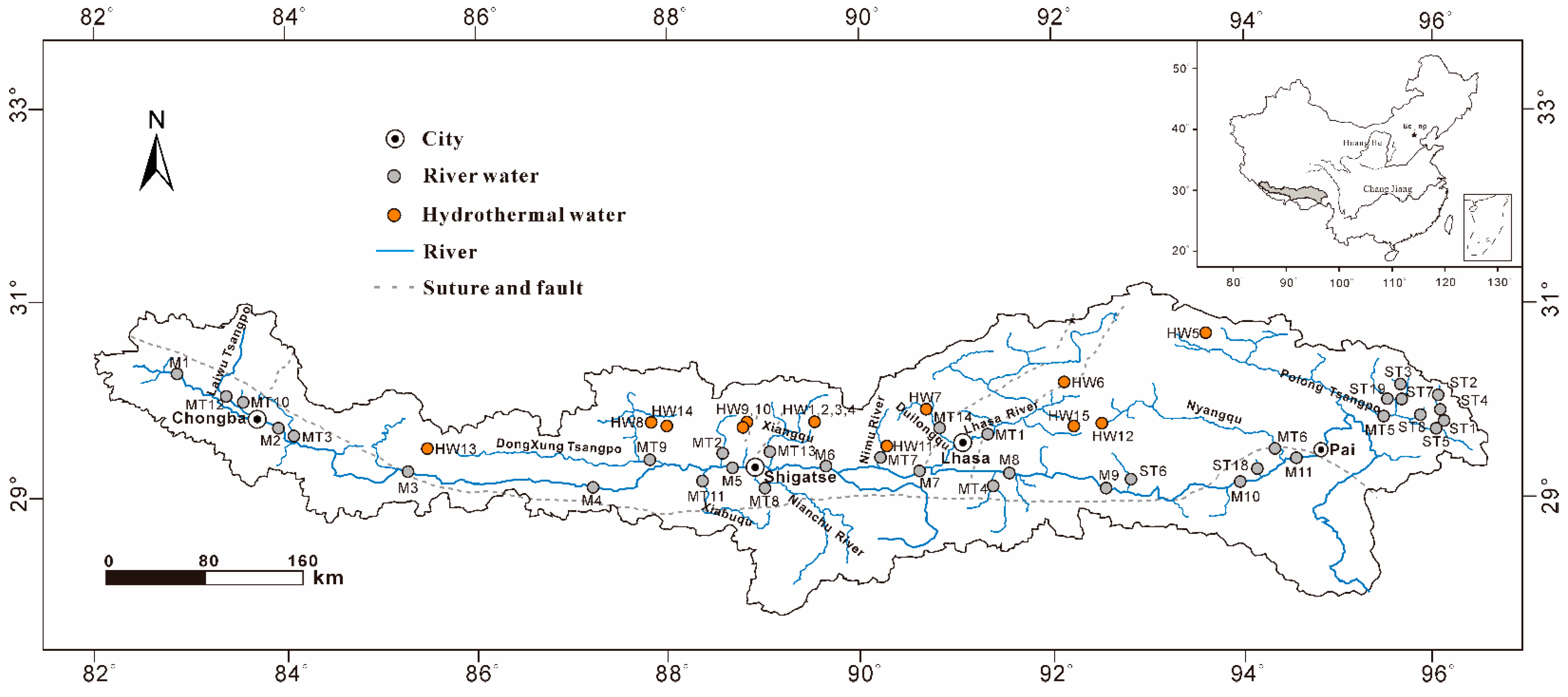
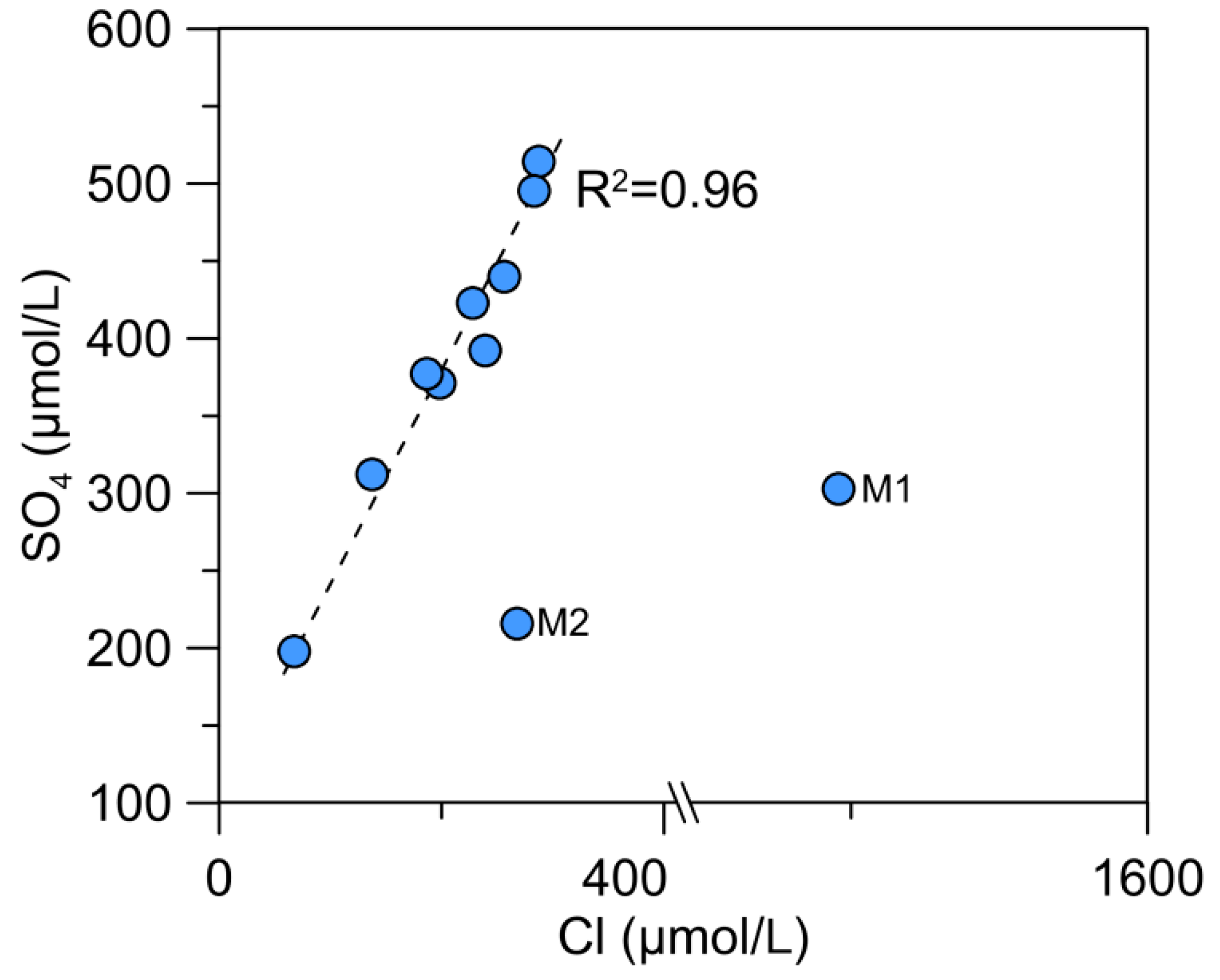

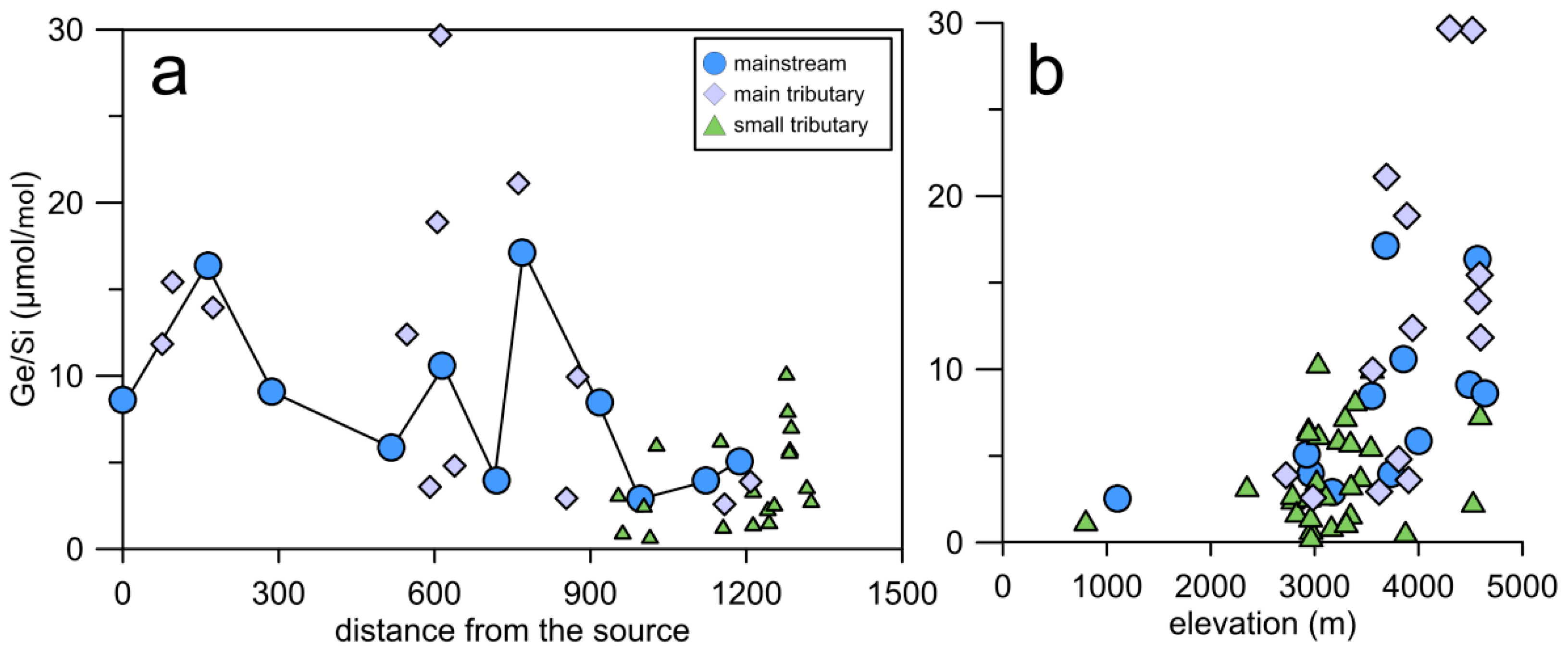
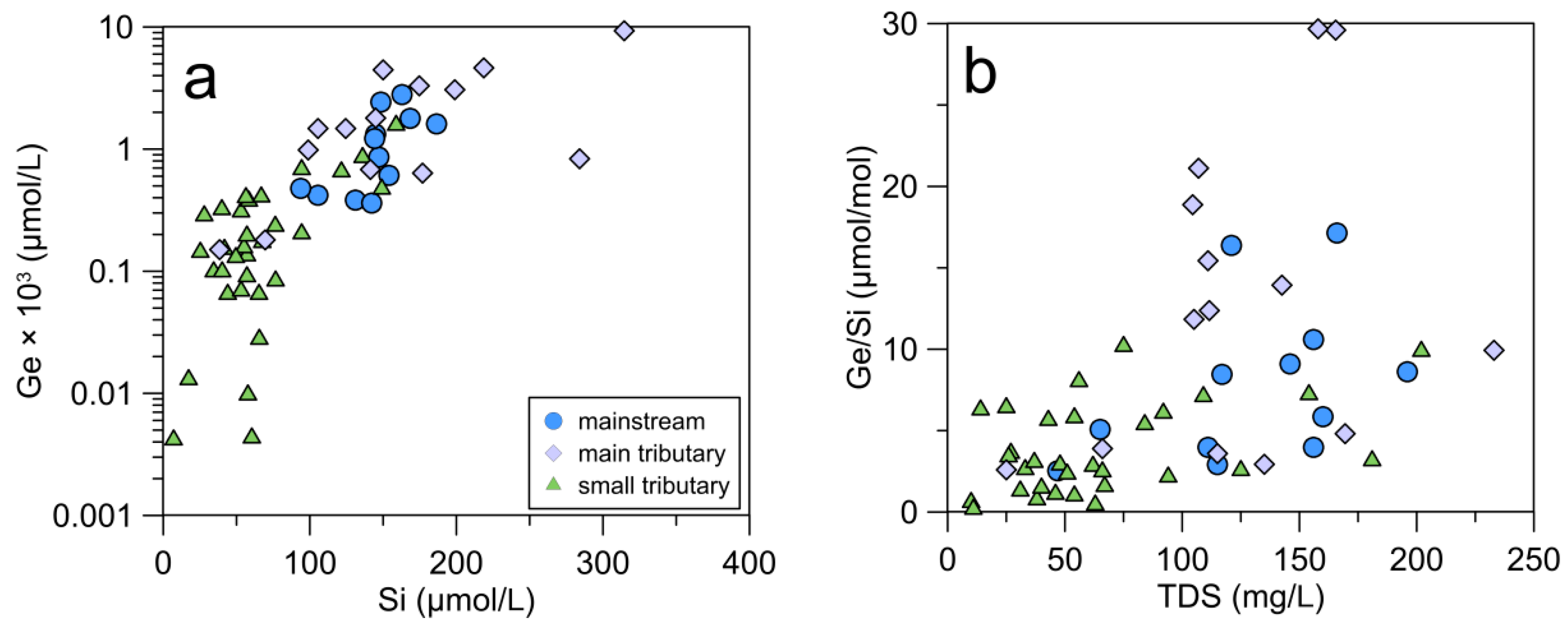
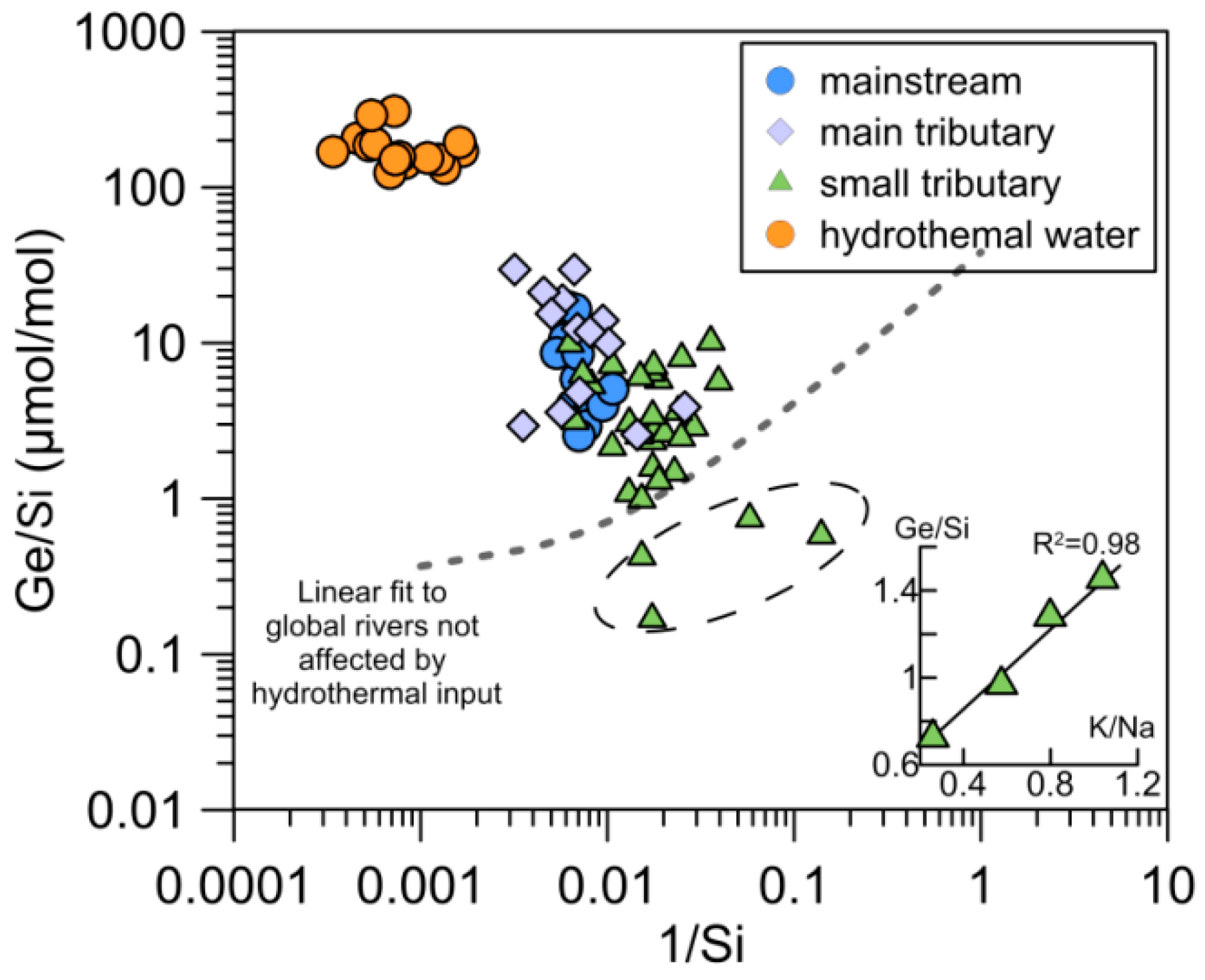
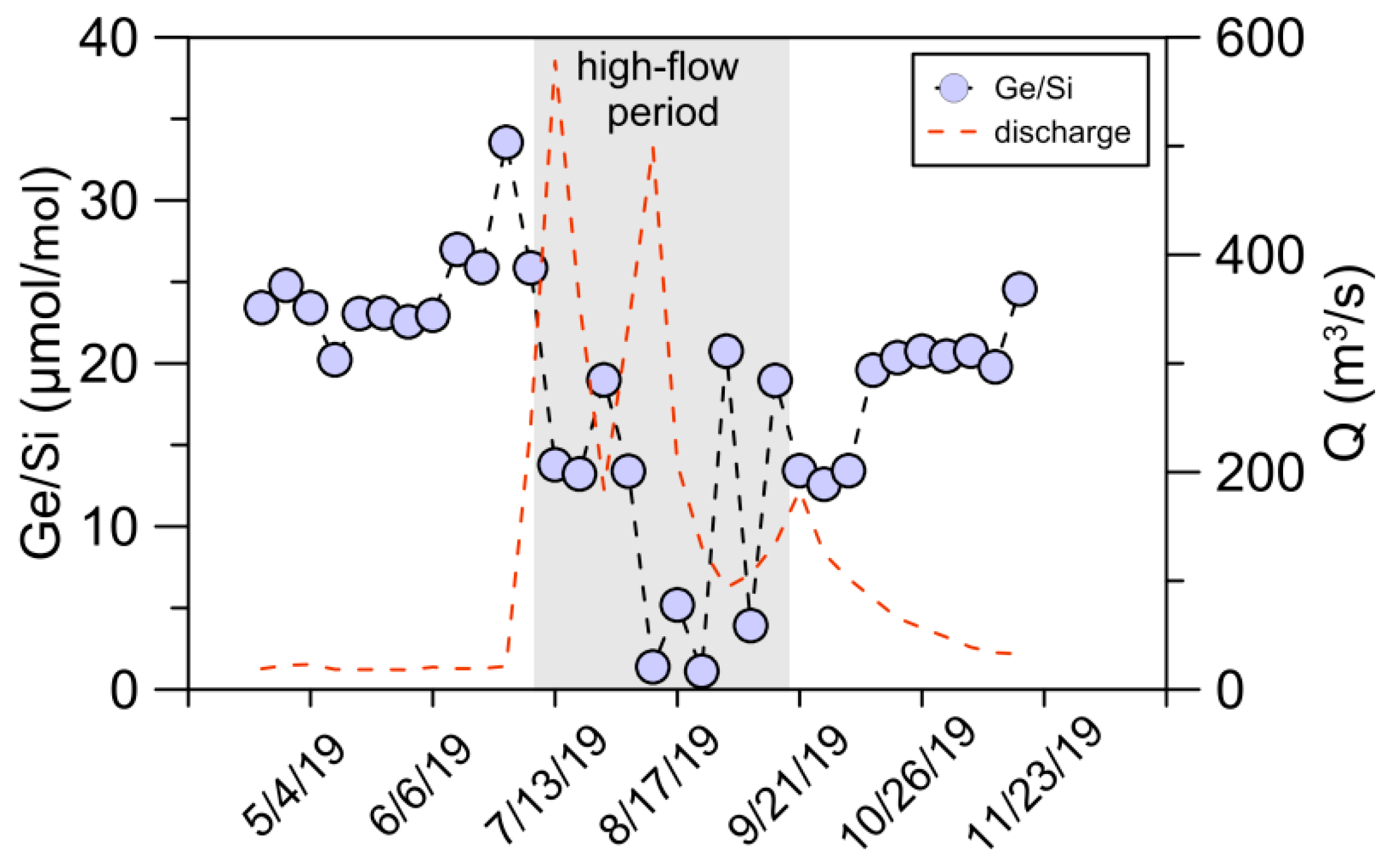
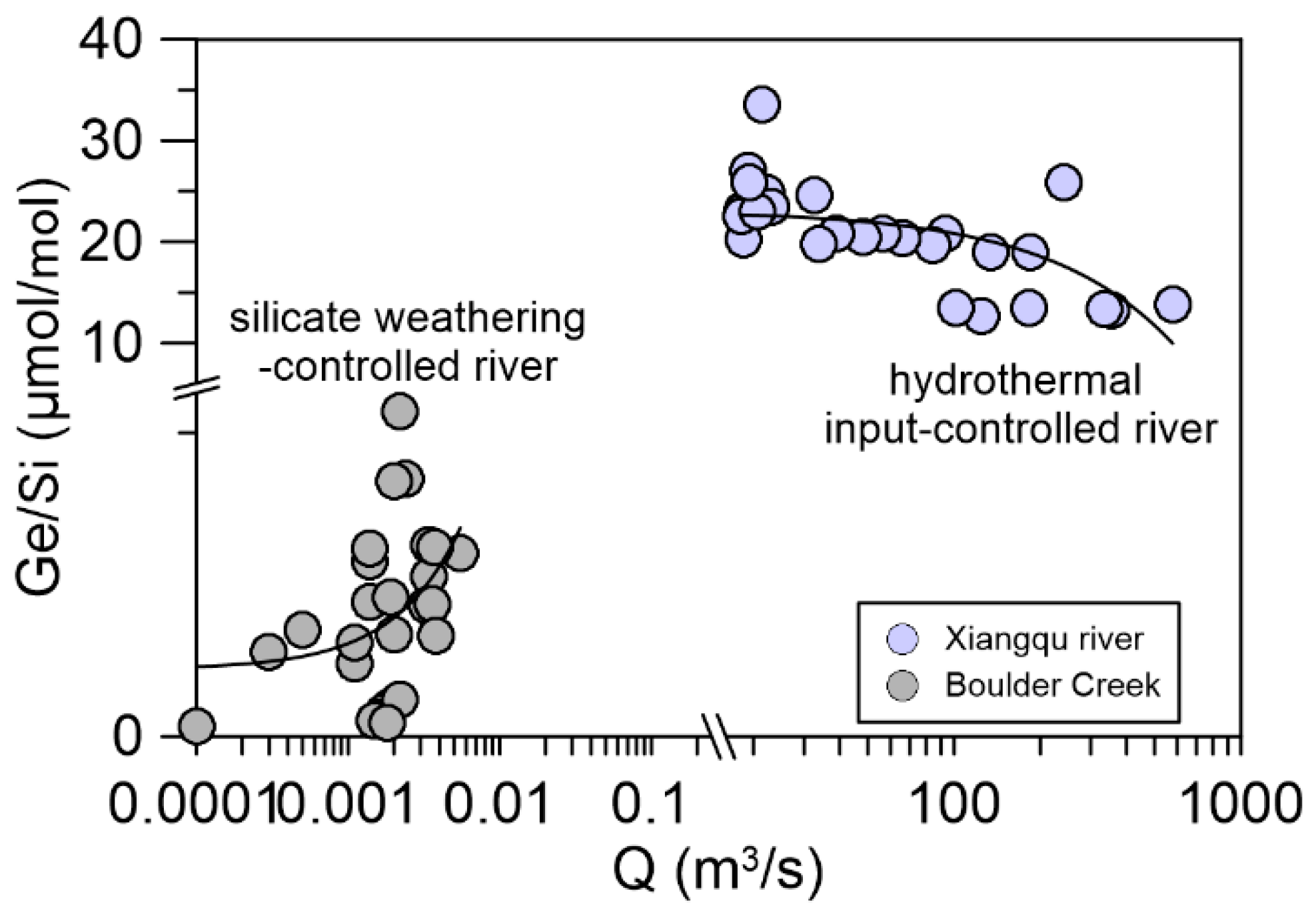
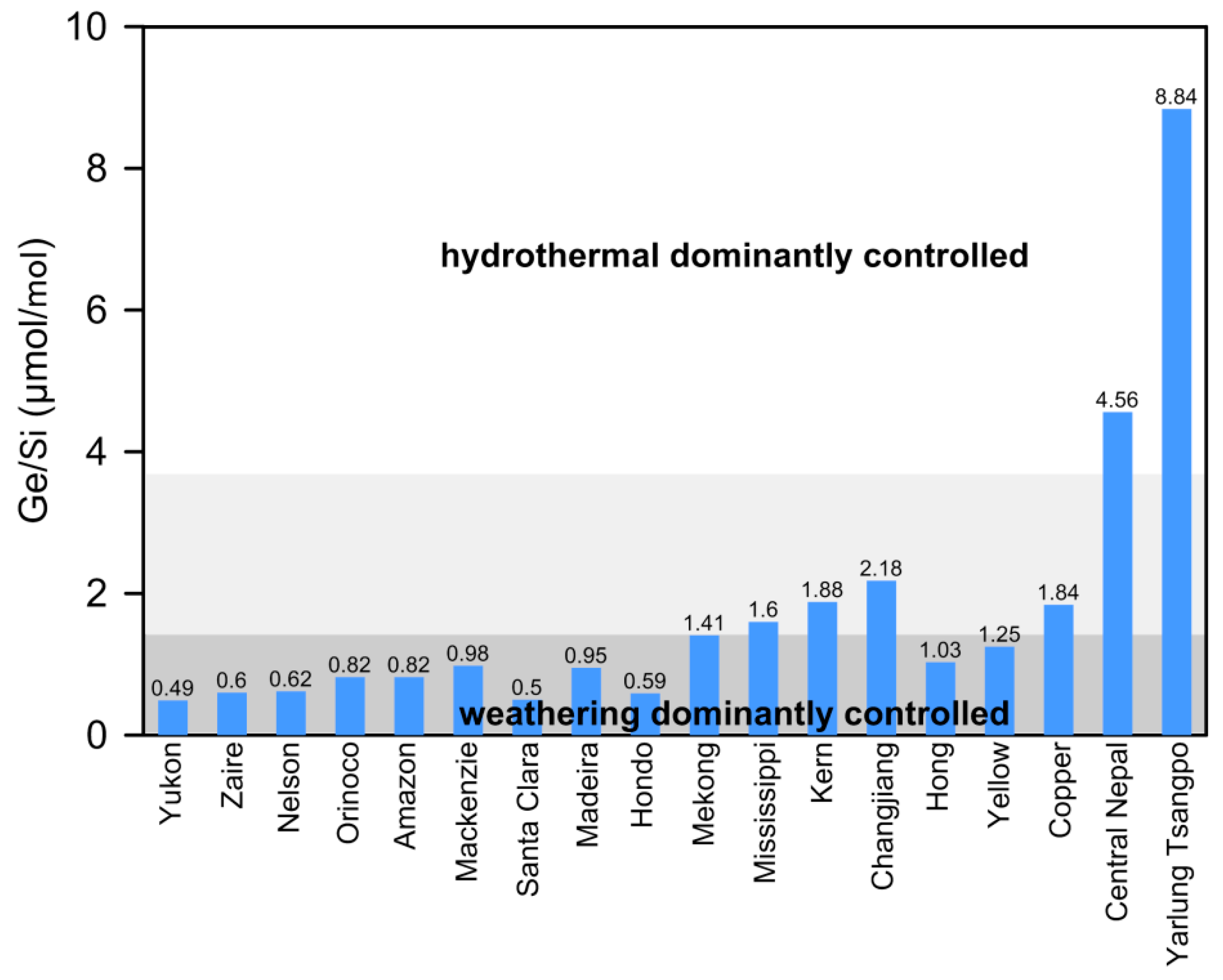
| Sample | Altitude | pH | T | TDS | Ge | Si | Ge/Si | Cl− | SO42− |
|---|---|---|---|---|---|---|---|---|---|
| (m) | (°C) | (mg/L) | (10−3 μmol/L) | (μmol/L) | (10−6 mol/mol) | (μmol/L) | (μmol/L) | ||
| Mainstreams | |||||||||
| M7 | 3685 | 8.54 | 13 | 166 | 2.8 | 163 | 17.1 | 256 | 440 |
| M6 | 3738 | 8.64 | 17 | 156 | 0.6 | 154 | 4.0 | 228 | 423 |
| M5 | 3856 | 8.56 | 20 | 156 | 1.8 | 169 | 10.6 | 239 | 392 |
| M4 | 4001 | 8.65 | 14 | 160 | 0.9 | 147 | 5.9 | 288 | 514 |
| M3 | 4489 | 8.51 | 13 | 146 | 1.3 | 145 | 9.1 | 283 | 495 |
| M2 | 4567 | 8.74 | 7 | 121 | 2.4 | 148 | 16.4 | 268 | 216 |
| M1 | 4637 | 8.05 | 10 | 196 | 1.6 | 187 | 8.6 | 1392 | 303 |
| M8 | 3552 | 8.56 | 18 | 117 | 1.2 | 144 | 8.5 | 198 | 371 |
| M9 | 3171 | 8.63 | 17 | 115 | 0.4 | 131 | 2.9 | 187 | 377 |
| M10 | 2964 | 8.35 | 19 | 111 | 0.4 | 106 | 4.0 | 137 | 312 |
| M11 | 2926 | 7.83 | 15 | 65 | 0.5 | 94 | 5.1 | 67 | 198 |
| Main tributaries | |||||||||
| MT1 | 3621 | 8.54 | 14 | 135 | 0.8 | 284 | 2.9 | 200 | |
| MT2 | 3890 | 8.32 | 13 | 105 | 3.3 | 175 | 18.9 | 127 | |
| MT3 | 4570 | 7.96 | 13 | 143 | 1.5 | 106 | 13.9 | 419 | |
| MT4 | 3558 | 9.01 | 10 | 233 | 1.0 | 99 | 9.9 | 172 | |
| MT5 | 2726 | 8.41 | 10 | 66 | 0.2 | 39 | 3.9 | 65 | |
| MT6 | 2982 | 8.22 | 13 | 25 | 0.2 | 70 | 2.6 | 55 | |
| MT7 | 3694 | 8.11 | 17 | 107 | 4.6 | 219 | 21.1 | 170 | |
| MT8 | 3807 | 8.39 | 14 | 170 | 0.7 | 141 | 4.8 | 200 | |
| MT9 | 3943 | 8.18 | 20 | 112 | 1.8 | 145 | 12.4 | 235 | |
| MT10 | 4595 | 8.02 | 6 | 105 | 1.5 | 124 | 11.8 | 216 | |
| MT11 | 3903 | 8.14 | 24 | 115 | 0.6 | 177 | 3.6 | 209 | |
| MT12 | 4587 | 8.60 | 10 | 111 | 3.1 | 199 | 15.4 | 151 | |
| MT13 | 4300 | 8.51 | 10 | 158 | 4.5 | 150 | 29.7 | 343 | |
| MT14 | 3745 | 7.25 | 15 | 129 | 4.6 | 145 | 31.6 | 606 | |
| Small tributaries | |||||||||
| ST1 | 3229 | 8.30 | 6 | 54 | 0.3 | 53 | 5.8 | 201 | 650 |
| ST2 | 3444 | 8.08 | 10 | 27 | 0.2 | 42 | 3.6 | 58 | 44 |
| ST3 | 2790 | 8.02 | 9 | 51 | 0.1 | 57 | 2.3 | 58 | 174 |
| ST4 | 3390 | 8.20 | 9 | 56 | 0.3 | 40 | 8.0 | 64 | 124 |
| ST5 | 3038 | 8.29 | 12 | 62 | 0.2 | 55 | 2.8 | 66 | 111 |
| ST6 | 3164 | 7.90 | 10 | 38 | 0.0 | 17 | 0.7 | 67 | 124 |
| ST7 | 3346 | 8.06 | 9 | 40 | 0.1 | 44 | 1.5 | 46 | 102 |
| ST8 | 2788 | 7.85 | 10 | 33 | 0.1 | 50 | 2.6 | 57 | 68 |
| ST9 | 3020 | 8.33 | 9 | 26 | 0.2 | 57 | 3.4 | 59 | 62 |
| ST10 | 3110 | 8.54 | 10 | 125 | 0.2 | 68 | 2.6 | 65 | 878 |
| ST11 | 3350 | 8.18 | 13 | 181 | 0.5 | 149 | 3.2 | 136 | 1043 |
| ST12 | 3297 | 8.25 | 8 | 109 | 0.4 | 57 | 7.1 | 47 | 245 |
| ST13 | 3036 | 7.55 | 9 | 92 | 0.4 | 67 | 6.1 | 58 | 728 |
| ST14 | 2830 | 8.38 | 4 | 67 | 0.1 | 57 | 1.6 | 65 | 179 |
| ST15 | 3032 | 7.90 | 11 | 75 | 0.3 | 28 | 10.2 | 66 | 196 |
| ST16 | 2961 | 7.62 | 14 | 31 | 0.1 | 53 | 1.3 | 63 | 103 |
| ST17 | 3345 | 7.98 | 9 | 43 | 0.1 | 25 | 5.6 | 57 | 91 |
| ST18 | 2942 | 7.59 | 14 | 14 | 0.9 | 136 | 6.3 | 47 | 45 |
| ST19 | 3303 | 8.07 | 11 | 54 | 0.1 | 65 | 1.0 | 47 | 209 |
| Hydrothermal water | |||||||||
| HW1 | 4581 | 8.72 | 45 | >2000 | 102 | 598 | 170 | 11,099 | |
| HW2 | 4596 | 8.68 | 43 | >2000 | 99 | 746 | 133 | 13,797 | |
| HW3 | 4580 | 8.62 | 53 | 1553 | 121 | 806 | 151 | 7537 | |
| HW4 | 4576 | 7.98 | 64 | 1899 | 174 | 1212 | 144 | 4930 | |
| HW5 | 4060 | 7.21 | 67 | >2000 | 428 | 1387 | 308 | 26,169 | |
| HW6 | 4435 | 7.09 | 44 | 838 | 142 | 917 | 155 | 3506 | |
| HW7 | 4511 | 8.01 | 54 | 932 | 121 | 618 | 195 | 13,873 | |
| HW8 | 4621 | 8.71 | 90 | >2000 | 451 | 2180 | 207 | 15,819 | |
| HW9 | 4591 | 7.54 | 71 | 1160 | 349 | 1880 | 185 | 3914 | |
| HW10 | 4556 | 8.04 | 88 | 1090 | 331 | 1743 | 190 | 2994 | |
| HW11 | 3898 | 8.63 | 53 | 322 | 181 | 1457 | 124 | 1491 | |
| HW12 | 4373 | 8.67 | 52 | 861 | 203 | 1295 | 157 | 5314 | |
| HW13 | 5010 | 8.62 | 86 | 900 | 500 | 2943 | 170 | 4527 | |
| HW14 | 3927 | 7.02 | 65 | 1567 | 533 | 1840 | 290 | 15,640 | |
| HW15 | 4275 | 6.99 | 49 | 1124 | 207 | 1370 | 151 | 5669 | |
Publisher’s Note: MDPI stays neutral with regard to jurisdictional claims in published maps and institutional affiliations. |
© 2022 by the authors. Licensee MDPI, Basel, Switzerland. This article is an open access article distributed under the terms and conditions of the Creative Commons Attribution (CC BY) license (https://creativecommons.org/licenses/by/4.0/).
Share and Cite
Wang, Y.; Zhao, T.; Xu, Z.; Sun, H.; Zhang, J. Ge/Si Ratio of River Water in the Yarlung Tsangpo: Implications for Hydrothermal Input and Chemical Weathering. Water 2022, 14, 181. https://doi.org/10.3390/w14020181
Wang Y, Zhao T, Xu Z, Sun H, Zhang J. Ge/Si Ratio of River Water in the Yarlung Tsangpo: Implications for Hydrothermal Input and Chemical Weathering. Water. 2022; 14(2):181. https://doi.org/10.3390/w14020181
Chicago/Turabian StyleWang, Yuchen, Tong Zhao, Zhifang Xu, Huiguo Sun, and Jiangyi Zhang. 2022. "Ge/Si Ratio of River Water in the Yarlung Tsangpo: Implications for Hydrothermal Input and Chemical Weathering" Water 14, no. 2: 181. https://doi.org/10.3390/w14020181
APA StyleWang, Y., Zhao, T., Xu, Z., Sun, H., & Zhang, J. (2022). Ge/Si Ratio of River Water in the Yarlung Tsangpo: Implications for Hydrothermal Input and Chemical Weathering. Water, 14(2), 181. https://doi.org/10.3390/w14020181






